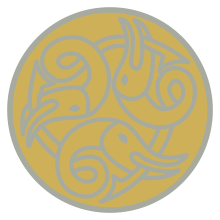| Benty Grange hanging bowl | |
|---|---|
 Escutcheon in the Weston Park Museum | |
 Reconstructed escutcheon design[note 1] | |
| Material | Bronze, enamel |
| Discovered | 1848 Benty Grange farm, Monyash, Derbyshire, England 53°10′29.7″N 1°46′58.8″W / 53.174917°N 1.783000°W |
| Discovered by | Thomas Bateman |
| Present location | |
| Registration | J93.1190; AN1893.276 |
The Benty Grange hanging bowl is a fragmentary Anglo-Saxon artefact from the seventh century AD. All that remains are parts of two escutcheons: bronze frames that are usually circular and elaborately decorated, and that sit along the outside of the rim or at the interior base of a hanging bowl. A third one disintegrated soon after excavation, and it no longer survives. The escutcheons were found in 1848 by the antiquary Thomas Bateman, while excavating a tumulus at the Benty Grange farm in western Derbyshire. They were presumably buried as part of an entire hanging bowl. The grave had probably been looted by the time of Bateman's excavation, but still contained high-status objects suggestive of a richly furnished burial, including the hanging bowl and the boar-crested Benty Grange helmet.
The surviving escutcheons are made of enamelled bronze and are 40 mm (1.6 in) in diameter. They show three dolphin-like creatures arranged in a circle, each biting the tail of the one ahead of it. Their bodies and the background are made of enamel, likely all yellow; the creatures' outlines and eyes are tinned or silvered, as are the borders of the escutcheons. Although three escutcheons from a hanging bowl at Faversham also contain dolphin-like creatures, the Benty Grange design is most closely paralleled by Insular manuscripts, particularly figures in the Durham Gospel Fragment and the Book of Durrow. Surviving illustrations of the third escutcheon show that it was of a different size and style, exhibiting a scroll-like pattern. It parallels the basal disc of a hanging bowl from Winchester and may have been originally placed at the bottom of the Benty Grange bowl.
What remains of one escutcheon belongs to Museums Sheffield and as of 2023 was in the collection of the Weston Park Museum. The other is held by the Ashmolean Museum at the University of Oxford; as of 2023, it was not on display.
Cite error: There are <ref group=note> tags on this page, but the references will not show without a {{reflist|group=note}} template (see the help page).
